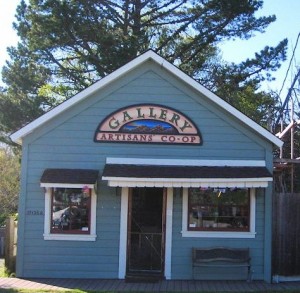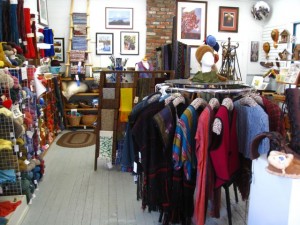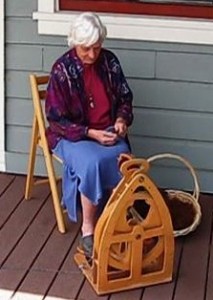
Artisans Co-op, Bodega, CA
The advantages of operating a shop in concert with a number of other artists are mainly in the savings to be had, both in time and money. The disadvantages are related to working with a varied group of often temperamental artists, and having to deal with all the regulations of running a business.
None of us had the time to run a business 7/7. Certainly no one alone had the funds for rent, power and phone. And most of us did not have enough product to fill a store, nor furniture for display space.
But together we could cover the calendar, pay the rent, and fill the shop.

The displays are rearranged monthly to keep the shop fresh and to highlight different artists.
I had tried dragging my wool and weavings to a few craft fairs, and quickly decided that it was not for me. So when a friend asked me to go in with her on a very small co-op shop in Glen Ellen, in spite of the commute distance, I jumped into the madness. The location was dodgy, customers were few, and it was difficult finding other people to join such a faltering enterprise. After a lackluster year, we relocated to Bodega, where two of the members had found a space to rent, and more artists to join in the new location.

Demos are important. They bring in customers and educate the public .
Most of us had not had experience in retail, so it took a lot of trial and error to get things to work right. In the original organization, we did not even have a phone, let alone a credit card account. The books were kept with pen and ink, and we used one member’s resale number to report our sales tax. Once we moved, and expanded the number of members, we had to get our own business accounts, and learn how to keep records on a computer. We have gone through quite a few forms of leadership in the last 16 years, some based on Robert’s Rules of Order, and some based on our own particular needs.
Currently, we have from 13 to 17 “full members” who each work in the shop two or three days a month, and pay a monthly fee to help with expenses. The rest of the artists are on consignment and do not work, but pay 45% commission on their sales. We have struggled to find a balance between paying the rent and only accepting artists whose work we feel is of a high enough quality, and we always struggle with how to reject an applicant who does not measure up.
We argued often in the early years about how to apportion space in the shop, and how to arrange the display cases, and, because artists are strongly opinionated, our disputes sometimes led to people walking out, of the meeting, or of the co-op. But over the years we have learned to temper our tempers and work together more smoothly.
Figuring out a method of running the shop, and making sure that everyone who works in it knows that method, is an ongoing concern. The working members have to know how to make out sales slips, correctly figure sales tax, run the credit card machine, take phone orders, and tally up the cash drawer at the start and end of the day. In addition, they have to clean a part of the shop, greet customers, answer questions, explain about the co-op, talk to prospective members and hand out applications. We have artists in many media among the full members, from glass workers to weavers and spinners, and we have to be sure that all of them can talk intelligently about each of the other mediums. Every so often, we have an “Explain Your Craft” segment at the monthly meeting. When we have new members, one of us works with her for a few days to train her. The manual of “Policies and Procedures runs to 15 or 20 pages, single spaced.
Full members are paid the full price of any sales so if your items sell well and you have the time to staff the shop, it is worth it to be a working member; if your items do not sell regularly, it is more advantageous to be a consignment member.